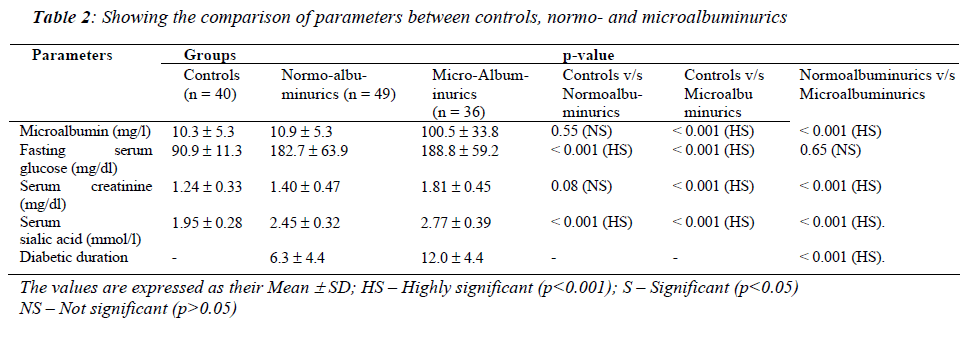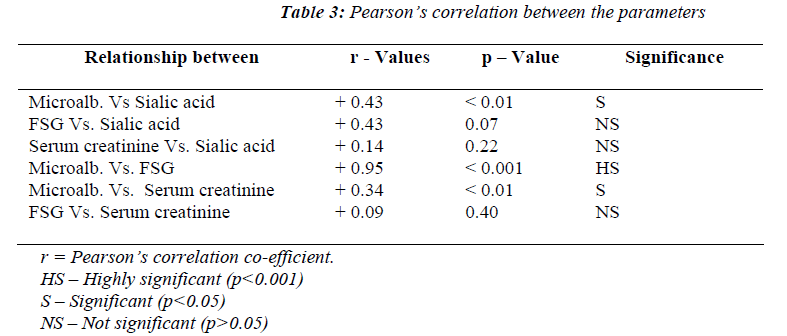ISSN: 0970-938X (Print) | 0976-1683 (Electronic)
Biomedical Research
An International Journal of Medical Sciences
- Biomedical Research (2011) Volume 22, Issue 1
Serum sialic acid and microalbuminuria in non insulin dependent diabetes mellitus
Krishnamurthy U.1*, Halyal S.S.2, Jayaprakash Murthy D.S.2
1Department of Biochemistry, M.S.Ramaiah Medical College, Bangalore, India
2Department of Biochemistry, J.J.M. Medical College, Davangere, India
- *Corresponding Author:
- Krishnamurthy U
Department. of Biochemistry,
M S Ramaiah Medical College
Bangalore-560054
Karnataka
India
Accepted date: September 21 2010
Serum sialic acid, an acute phase reactant and urinary albumin excretion are found to be increased in various conditions like diabetes mellitus, cardiovascular diseases, cancer etc. In diabetes mellitus, acute phase reactants are considered as the indicators of microvascu-lar angiopathy. Therefore, the present study was undertaken to understand the potential association of serum sialic acid levels in diabetic process and to assess the correlation be-tween serum sialic acid concentration and microalbuminuria. 85 non-insulin dependent diabetes mellitus (NIDDM) patients were studied for their urinary albumin, serum sialic acid, fasting serum glucose and serum creatinine levels. Analysis was performed by catego-rizing them based on their albumin excretion (normoalbuminuric & microalbuminuric). 40 non-diabetic healthy subjects were chosen as a control group. Analysis showed 49 (57.6%) subjects had normoalbuminuria and 36 (42.3%) had microal-buminuria. Serum sialic acid concentrations found to be elevated in NIDDM (2.58 mmol/L) patients when compared to controls (1.95 mmol/L) and more so with microalbuminuric (2.77 mmol/L). There is a progressive rise in serum sialic acid levels with increase in urnary albumin excretion in NIDDM patients. Therefore, sialic acid can be of useful parameter to follow up the diabetic process.
Keywords
Microalbuminuria, Serum sialic acid, Diabetes mellitus.
Introduction
Diabetes mellitus is the most common endocrine disor-der, the prevalence of which is rising alarmingly in India [1]. The International Diabetes Federation (IDF) esti-mates the total number of diabetic subjects in India to be around 40.9 million and this is further set to rise to 69.9 million by the year 2025 [2]. Diabetes mellitus is char-acterized by metabolic abnormalities and on long term with micro and macro vascular complications that cause significant morbidity and mortality among diabetic sub-jects [3]. Various acute phase reactants are being studied in diabetic process as indicators or predictors of diabetic microvascular complications. Serum sialic acid has been found to be an acute phase reactant [4] and its estima-tion in NIDDM is very little emphasized. Hence this study was undertaken to find the levels of serum sialic acid in NIDDM.
Diabetic nephropathy occurs in about 25-30% of dia-betic patients. However, there is an early phase of dia-betic renal disease called incipient diabetic nephropathy characterized by increased albumin excretion in the range of 30-200 mg/l (microalbuminuria). At this stage urine is negative for standard dipsticks and renal func-tion is normal by standard clinical tests but can be de-tectable only by the use of sensitive assay [5]. Incipient diabetic nephropathy has been proved to be reversible with tight glycemic control and ACE inhibitors [6]. Therefore, we intended to correlate serum sialic acid with microalbuminuria which is a marker of early renal damage to establish the role of estimation of serum sialic acid in NIDDM.
Materials and Methods
This study was under taken in the department of bio-chemistry, J J M medical college, Davangere, after the approval of the research and ethical committees. The es-tablished NIDDM patients attending the OPD of the Bapuji hospital, Davangere were tested for urinary al-bumin by albustix method. Urinary albumin positive subjects were excluded and albustix negative NIDDM patients which constituted 85 were recruited into the study. Patients with inflammatory disorders like eczema, secondary hyperglycemic states like hypothyroidism, proteinuric conditions like congestive cardiac failure, renal failure and pregnancy were excluded. Female pa-tients with menstrual disorders were also excluded an-ticipating the presence of non specific inflammation. 40 healthy age matched volunteers were chosen as controls. A total of 125 subjects were studied. Fasting serum samples and urinary samples were collected from all the study subjects. Urinary albumin was quantitated using an ELISA kit [7] (UBI MAGIWEL, Enzyme Immuno Assay Microalbumin, US). Serum sialic acid was esti-mated by Thiobarbituric acid assay of Warren [8]. Fast-ing serum glucose and serum creatinine was estimated in an autoanalyser by glucose oxidase method [9] and Jaffe’s method [10] respectively. Quantitative data summarized to test the difference in mean values ob-tained for NIDDM patients and controls using student ‘t’ test, p value < 0.05 is taken as the level of signifi-cance. Further, Pearson’s correlation was used to corre-late between the different parameters.
Results
The study included 40 controls (21 males, 19 females) and 85 diabetics (50 males, 35 females). Both cases and controls were aged between 30 to 70 years. Results are shown in the tables 1, 2 and 3. Table 1 shows the Mean ± SD of serum sialic acid levels, albumin excretion, mean fasting serum glucose and serum creatinine in controls and NIDDM patients. All the parameters were found to be elevated in NIDDM patients. Table 2 shows the categorization of NIDDM patients into normo and microalbuminurics based on their albumin excretion. Among 85 NIDDM patients, 49 (57.6%) subjects had normoalbuminuria and 36 (42.3%) had microalbuminu-ria. Serum sialic acid levels show a progressive rise with the urinary albumin excretion (1.95 ± 0.28, 2.45 ± 0.32 & 2.77 ± 0.39 in controls, normoalbuminurics & micro-albuminurics respectively), where as serum creatinine showed significant increase only in microalbuminuric patients. It can also be noted that serum sialic levels show significant difference between controls and nor-moalbuminuric patients (p<0.001) where as serum creatinine and albumin excretion levels shows no statis-tical difference. It is also seen that diabetic duration was more with microalbuminurics (12.0 ± 4.4 years vs 6.3 ± 4.4 years in normoalbuminurics). Fasting glucose levels showed no significant difference in their levels when compared between the normo & microalbuminurics (2.45 ± 0.32 & 2.77 ± 0.39 mg/dl respectively). Table 3 show the Pearson’s correlation between the parameters. There is a significant positive correlation between microalbumin excretion and sialic acid.
Discussion
Inflammation plays a major role in the pathogenesis of type 2 diabetes mellitus and its complications [11]. Hence inflammatory markers or acute phase markers have gained the importance as indicators and predictors of dia-betic process. Serum sialic acid is one of the acute phase response markers that is found to be associated with dia-betes mellitus [12]. In our study we observed a progres-sive rise in serum sialic acid levels with the urinary albu-min excretion and a significant positive correlation be-tween them. It is noted that there is significant difference in serum sialic levels between controls and normoalbu-minuric patients, which was not shown with serum creatinine and albumin excretion levels. Serum creatinine showed significant increase only in microalbuminuric patients suggesting its importance only after the onset of nephropathy. Therefore, sialic acid may act as an indica-tor for early diabetic process. Crook MA, et al attribute the increase in serum sialic acid concentrations in diabetes to cytokine induced, which is produced in excess in dia-betic process [13]. Microalbuminuria a resultant of hy-perglycemia induced glycation of glomerular membrane [14]. Jorgensen et al [15] and Mayurasakorn K et al [16] have shown that tight glycemic control reverses the mi-croalbuminuric state and may delay the onset of compli-cations but does not halt the ongoing microvascular dam-age. Therefore, monitoring of diabetic patients with serum sialic acid levels may help in predicting the onset of mi-crovascular changes. Since this is a cross sectional study, follow up studies and interventional studies are required to emphasize the importance of sialic acid estimation. Since the underlying inflammation is the cause for estab-lishing the diabetes and its complications, our study would have been strengthened if we had measured the inflammatory marker like hsCRP and correlated with se-rum sialic acid levels.
In conclusion, estimation of both microalbuminuria and serum sialic acid levels in NIDDM is helpful in assessing the diabetic process and identifying the risk category for complications which are the main causes for mortality and morbidity among diabetes mellitus patients.
References
- Ramachandran A. Epidemiology of diabetes in India--three decades of research. J Assoc Physicians India. 2005;53:34-8
- Sicree R, Shaw J and Zimmet P. Diabetes and impaired glucose tolerance. In: Gan D, editor. Diabetes Atlas. In-ternational Diabetes Federation. 3rd ed. Belgium: In-ternational Diabetes Federation; 2006 p. 15-103.
- Zargar AH, Wani AI, Masoodi SR, Laway BA and Bashir MI. Mortality in diabetes mellitus - data from a developing region of the world. Diabetes Res Clin Pract 1999; 43: 67-74.
- Taniuchi K, Chifu K, Hayashi N, Nakamachi Y, Ya-maguchi N and Miyamato Y: A new enzymatic method for the determination of sialic acid and its application as marker of acute phase reactants. Kobe J Med Sci 27:91–102, 1981
- Powers AC. Diabetes Mellitus, Chapter 338. In: Fauci AS, Braunwal E, and Eds. Harrison’s Principles of In-ternal medicine, 17th edn. New York: Mc Graw Hill 2008: 2275 - 2304.
- Zelmanovitz T, Gerchman F, Balthazar AP, Thomazelli FC, Matos JD, Canani LH. Diabetic nephropathy. Diabetol Metab Syndr. 2009; 1:10.
- Fielding BA, Price DA and Houlton CA. Enzyme im-munoassay for urinary albumin. Clinical Chemistry 1983; 29:355-7.
- Warren L. The Thiobarbituric acid assay of sialic ac-ids. Journal of biological chemistry 1959; 238: 1971 – 75.
- Lott JA, Turner K. Evaluation of Trinder's glucose oxi-dase method for measuring glucose in serum and urine. Clin Chem. 1975; 21:1754-60.
- Lamb E, Newman DJ and Price CP. Kidney Function Tests, Chapter 24. In: Burtis CA, Ashwood ER, Eds. Tietz textbook of clinical chemistry and molecular di-agnostics, 4th edn. Philadelpohia: WB Saunders Com-pany 2006: 798-81
- Schmidt MI, Duncan BB, Sharrett AR, Lindberg G, Savage PJ, Offenbacher S, Azambuja MI, Tracy RP,Heiss G. Markers of inflammation and prediction of diabetes mellitus in adults (Atherosclerosis Risk in Communities study): a cohort study. Lancet. 1999;353:1649-52
- Ozben T, Nacitarhan S, Tuncer N. Plasma and urine sialic acid in non-insulin dependent diabetes mellitus. Ann Clin Biochem. 1995; 32:303-6.
- Crook MA, Pickup JC, Lumb PJ, Giorgino F, Webb DJ, Fuller JH Relationship between plasma sialic acid concentration and microvascular and macrovascular complications in Type-1 diabetes; the EURODIAB Complications Study. Diabetes care 2001; 24: 316 – 22.
- Chowta NK, Pant P, Chowta MN. Microalbuminuria in diabetes mellitus: Association with age, sex, weight, and creatinine clearance. Indian J Nephrol. 2009; 19:53-6.
- Dahl-Jorgensen K, Brinchmann-Hansen O, Hanssen KF, Ganes T, Kierulf P, Smeland E et al. Effect of near normoglycaemia for two years on progression of early diabetic retinopathy, nephropathy, and neuropathy: The Oslo Study. Br Med J 1986;293:1195-1199
- Mayurasakorn K, Somthip N, Caengow S, Chulkarat N, Wanichsuwan M. Glycemic control and microvascular complications among type 2 diabetes at primary care units. J Med Assoc Thai. 2009; 92:1094-101.


